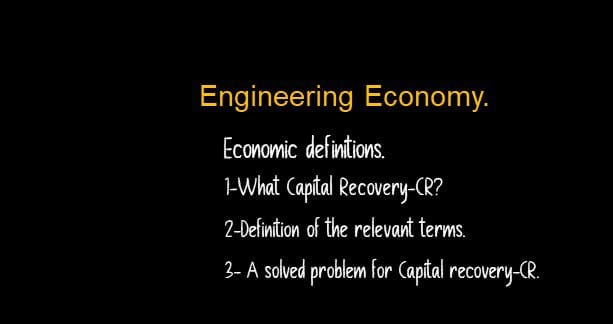What is Capital Recovery in the Economy?
18 The new Item is Capital recovery or CR; From Investopedia, Capital recovery or CR stands for Capital recovery is a term that has several related meanings in the world of business. It is, primarily, the earning back of the initial funds put into an investment. When an investment is first made in an asset or a company, the investor initially sees a negative return, until the initial investment is recouped.
The return of that initial investment is known as capital recovery. Capital recovery must occur before a company can earn a profit on its investment.
If you wish to review the pdf data used in the illustration, please continue reading.
This is the Title of the Content that will be included in this post and in the next post.
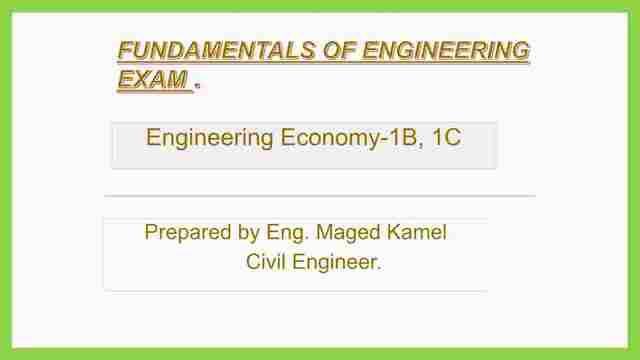
These are the objectives of this lecture, but in this post, we will discuss Capital Recovery.
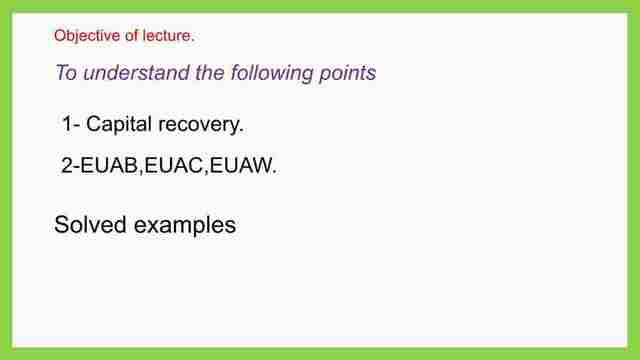
Capital recovery is the equivalent annual cost of obtaining the Assets plus the Salvage, and we convert the Purchase price. The Capital is divided into two parts, the purchase price or the initial investment P and the salvage price. The salvage price is the selling price of the equipment at the end of its life.
There are two values of great concern for a capital recovery: Purchase price & earning and Salvage. These values are converted to annual worth. As we remember, these annual worth are values that are equally spaced in time. I quote, Aw is comprised of two components. The capital recovery for the initial investment P at a stated interest rate (MARR) and the equivalent annual amount A.
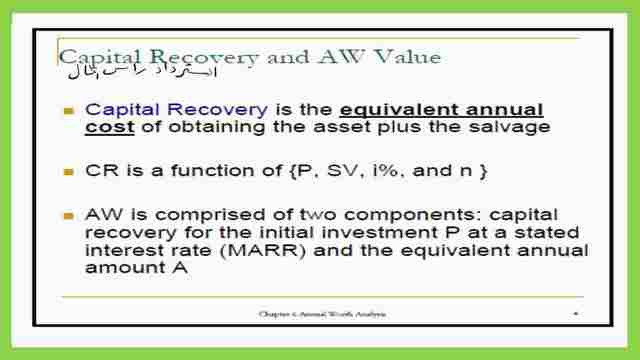
We have P as the initial investment in the next slide, the total first Cost of all assets and services. They are required to initiate the alternative. While the salvage value (SV)-The terminal estimated value of Assets at the end of their useful lives.
Term A is the Annual amount, the equivalent annual amount; typically, this is the annual operating Cost (AOC). We will discuss these terms in the coming solved problem, in God’s will.
First, the initial investment then considers the operating costs in the form of an Annual amount and then compares alternatives. Compare the purchase price and maintenance cost and then evaluate the capital recovery.
The maintenance is bigger or smaller than the profit that he can achieve from the given option at the end. There is a stated MARR that the company defines. These are the objectives of this lecture, but in this post, we will discuss Capital Recovery.
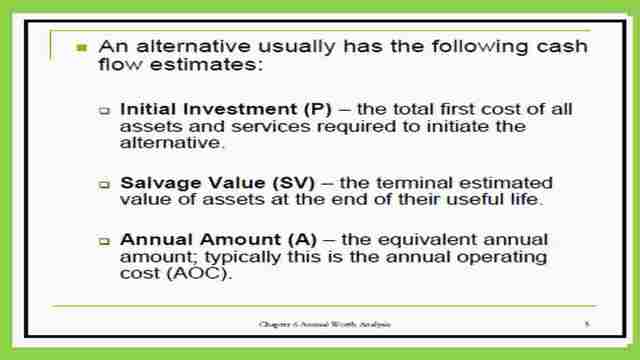
The General equation to estimate Capital recovery.
To convert into annual values. We have two values; the General monetary transaction Associated with the purchase and eventual retirement of a capital asset is its initial Cost (I), and its salvage value (S) takes these sums into account.
The capital recovery CR(I) at the stated Interest as MARR or as given in the example is equal to An investment that I(A/P, I, N), which is then converted P into annual value by the relation A/P. Where i is the stated interest rate and N is the number of years, which are the lifetime minus the salvage S, the price at the end, or the future worth, to be returned as A multiplied by (A/F) factor, I, N.

This is the other alternative equation for CR(I).In the next slide, as we can see, we have an investment I as cash out, and while there is a cash-in at the end S. This cash in and out can be converted into CR(I), the capital recovery with an equal amount and equal periods same as annual worth. The A is cash out considered a negative value.
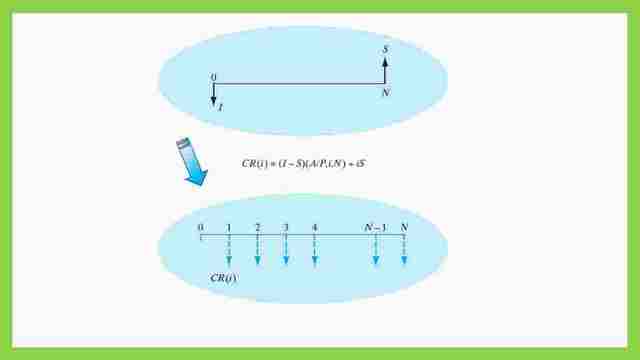
A Solved problem for capital recovery.
We have a solved problem. Consider a machine that costs $20,000 and has five – year useful life. At the end of the five years, it can be sold for $4000— the annual operating and maintenance are $500. The firm can earn after tax $5,000 per year with this machine.
In the cash flow diagram, we draw A annual worth as upward arrows as cash-in from time t=1 to t=5. Should it be purchased at an interest rate of 10%? All benefits and costs associated with the machine are accounted for in these figures. We need to estimate the capital recovery Using the equation CRI ( A/P, I, N).-S(A/F, I, N). The interest rate is given as 10%, N value=5 years.

We can use the tables for i%=10% and N=5 years.
We get the value of A/P; the value is 0.2638. We get the value of A/F=0.1638. The purchase price of 20,000 to be multiplied by 0.2638 will produce a downward A value. We need to estimate the capital recovery Using the equation CRI ( A/P, i, N).-S(A/F, I, N).
The interest rate is given as 10%, N value=5 years. We get the value of A/P; the value is 0.2638. We get the value of A/F=0.1638.The purchase price of 20,000 to be multiplied by 0.2638 will produce a downward A value. We can use the tables for i%=10% and N=5 years.
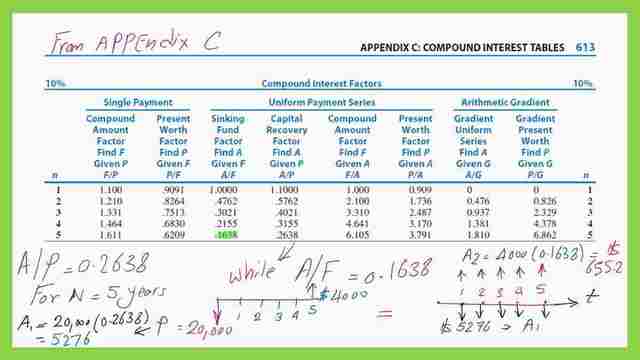
While the salvage value of $4000 is to be multiplied by 0.1638 and will be considered upward. We make a sum=-5276+655.2. We get =-4620.8 and include $500 as operation pointing downwards.So we get =-4620+(-500)=-5120.8.
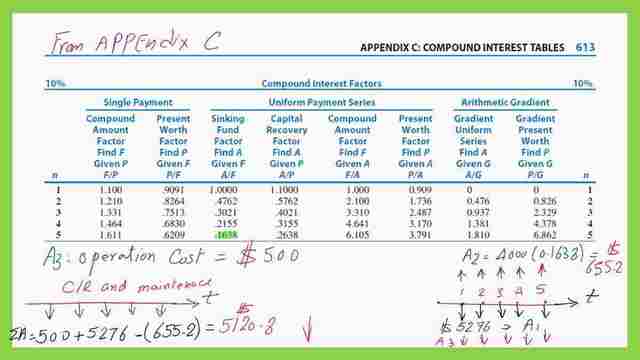
This is the alternative equation, which we can use to get The Value of CR(I), this equation will produce the final value of Cr exactly the same value as estimated by letting CR((I)=I(A/p,I, N)-S(A/F, I,N)
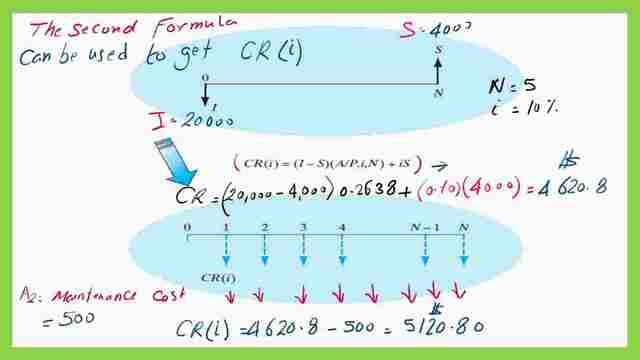
While from revenue we have income =$5000. So finally, there is a loss, which is equal to (-5120.80+5000=-120.80. This value is the difference between the revenue and The Cost of Capital. Then the offer is to be rejected. This is the final solution done on one page using the formula for CR, Capital recovery.
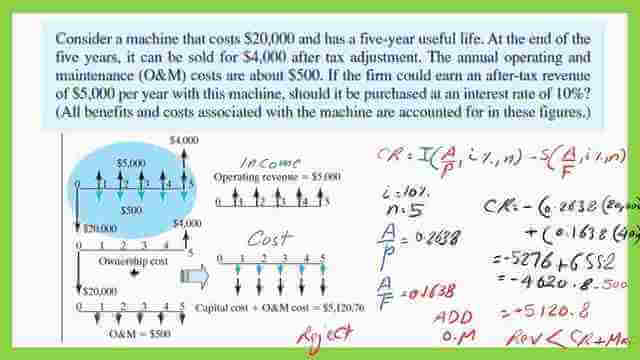
In the next post we will review the different terms EAB, EAC, and EAW, there is a solved example that demonstrates the photo use of EAC to check whether an investment is profitable or not.
This is the link to download the pdf files.
For a useful external resource, Engineering EconomyA good referance.
